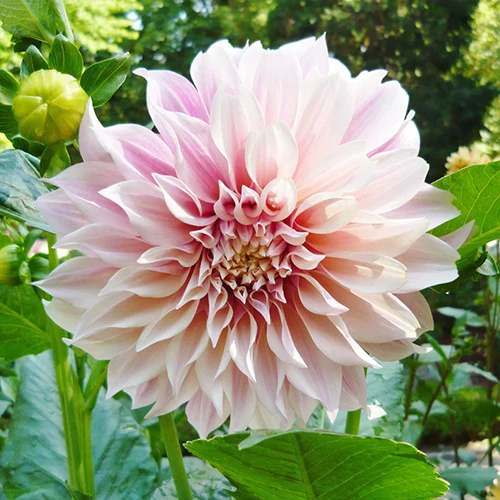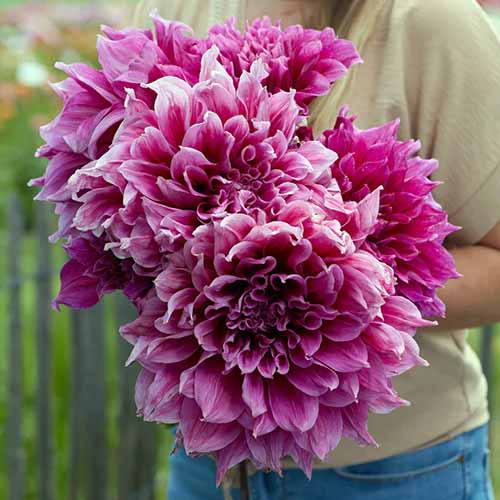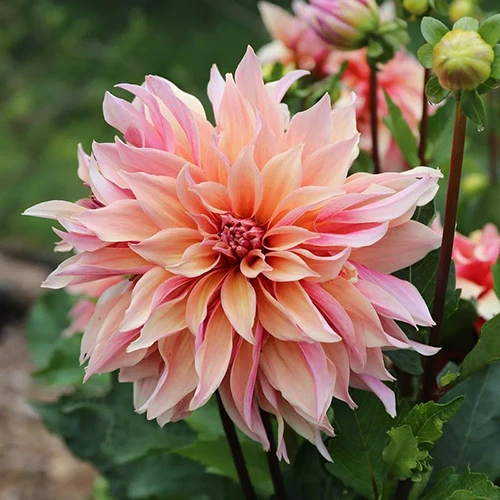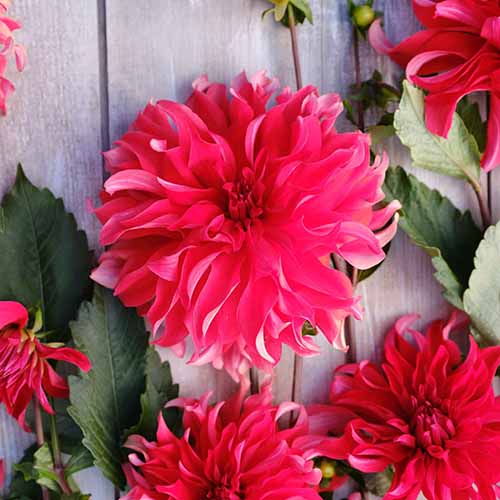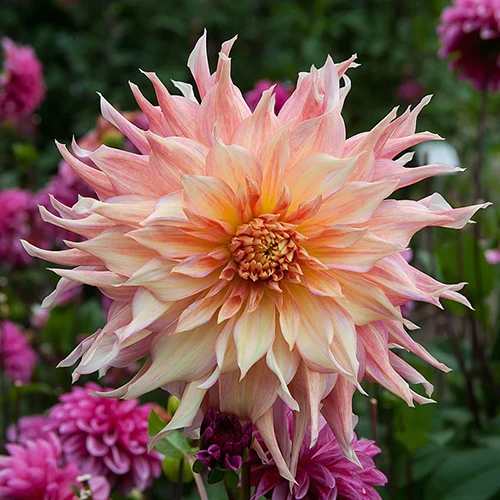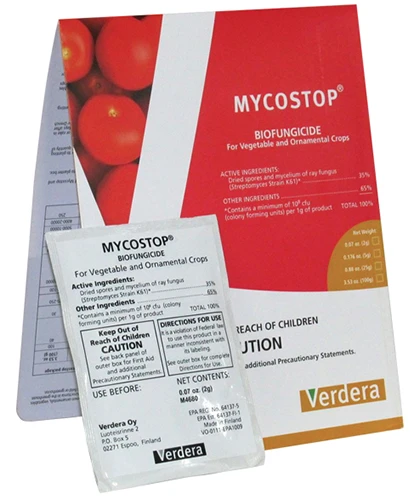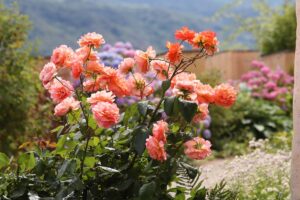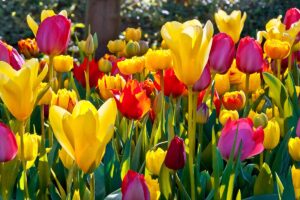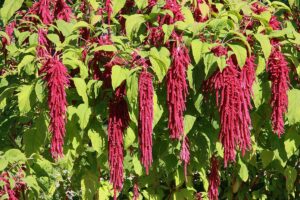Dahlia hybrids
Dahlias aren’t for the shrinking violets of the world. They’re brash, bold, and loud.
And of the many dahlia types, dinnerplates are perhaps the most attention-grabbing. You certainly wouldn’t want to plant them if your vibe is more “look over there” than “look at me.”
If you don’t mind turning heads, though, you’d be hard-pressed to find a better option.
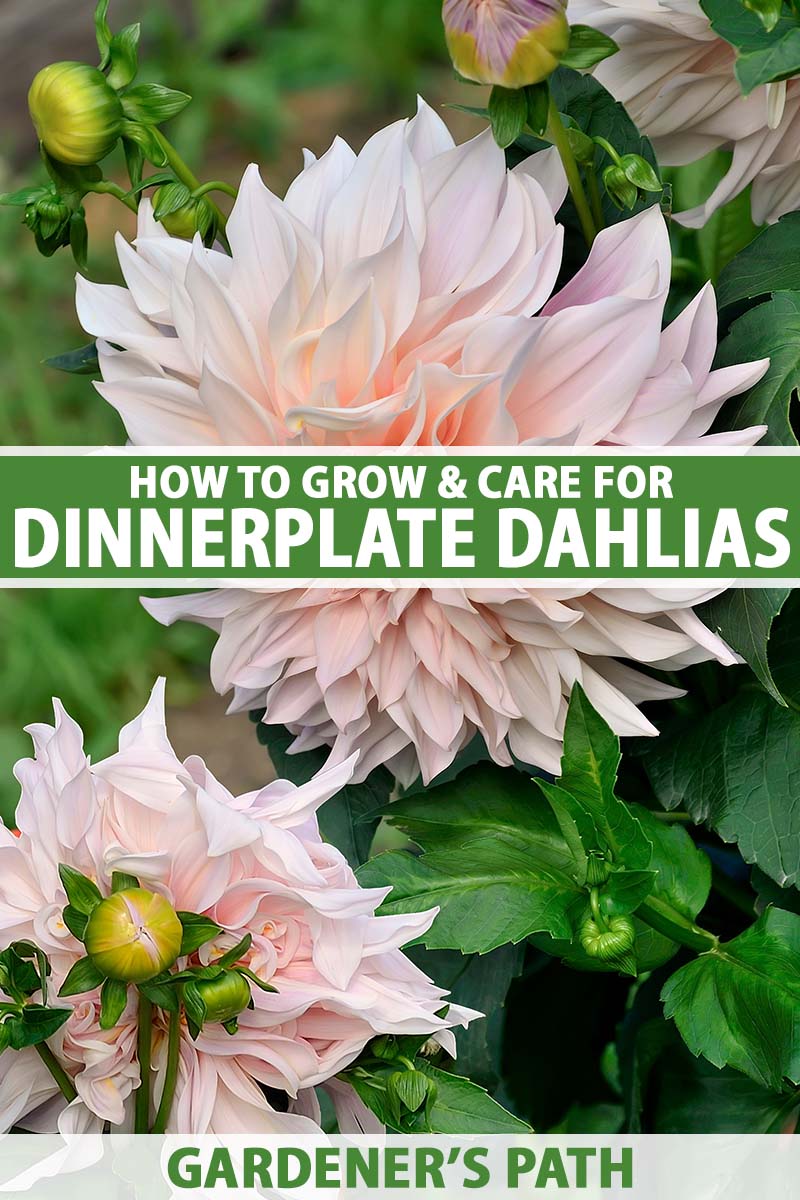
We link to vendors to help you find relevant products. If you buy from one of our links, we may earn a commission.
But dinnerplate dahlias need special care to keep them looking their finest. These aren’t plants you can just toss in the ground and forget about if you want them to look their best.
This guide will help you to make that happen. With this goal in mind, here’s what we’re going to discuss:
What You’ll Learn
If you live in Zones 8 to 10, you can grow these as you would your typical perennial. If you live in a cooler USDA Hardiness Zones, you’ll need to dig up and protect the tubers during the winter.
If you’re ready to add this “wow” factor to your garden, you’re probably rarin’ to go. Without further ado, let’s dig in!
Cultivation and History
Dahlias were originally cultivated as a food crop in Mexico. These plants are related to sunflowers and Jerusalem artichokes, and the tubers can be incredibly tasty.
When explorers brought dahlias back to Europe they intended to grow them as a food crop there, but they never caught on. Or, at least they never caught on as an edible.

As ornamentals, dahlias were a bona fide winner.
Those flower-breeding superstars, the Belgians, started creating the first dinnerplate dahlias in the early 1800s. By the 1920s, dahlias were all the rage in the US and Europe, and many new dinnerplates were bred.
Of those, only a few are still around. ‘Thomas Edison,’ ‘Kelvin Floodlight,’ and ‘Snow Country’ are some of the oldest cultivars still on the market.
But don’t feel deprived – the newer dinnerplates are big, bold, and tougher than ever before.
By the way, “dinnerplate” just means that the flowers are large. It doesn’t denote a particular species or group of cultivars.
Anything that can grow at least eight inches across is considered a dinnerplate type and they’re all hybrids, usually with the hortensis species somewhere in their lineage.
The first blossom of the season is usually the largest, and any successive flowers on a given plant will typically be smaller.
The plants themselves typically grow over four feet tall and almost all of them require staking, since those giant heads are heavy – usually heavier than the stems can support.
Propagation
Dinnerplates can be propagated in all the same ways that other dahlias can be.
Buying a live plant or tubers is the easiest way to go, but propagating cuttings or taking divisions is a good way to save a buck or reproduce a specimen that you particularly like.
From Seed
You can purchase dahlia seeds at many retailers, but you won’t find dinnerplate seeds.
You can collect them from existing plants but these seeds won’t grow true, meaning the resulting seedlings won’t necessarily look like the parent plant.
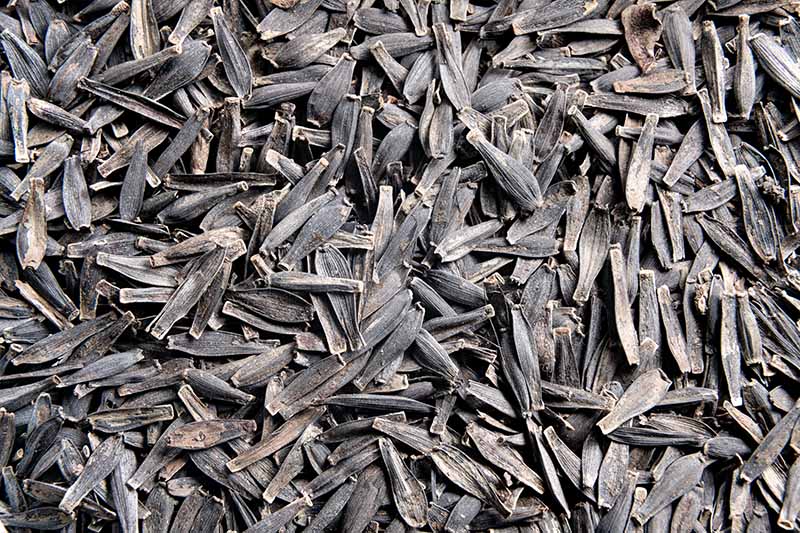
To collect the seeds, wait until the pods form on the stem after the flower fades. That means no cutting the flowers for arrangements.
Once a pod plumps with a dark, dry center at the pointed end, it’s about ready. As the outer parts of the pod start to turn dark and dry, harvest it and place it in a cool, dry spot.
When it’s completely dry, rub the pod between your hands to release the seeds. They’ll be plump and dark brown or black. Any smaller, tan-colored seeds weren’t pollinated and they aren’t going to be viable.
To sow the seeds, wait until about eight weeks before the last predicted frost date in your area. Fill four-inch pots with well-draining potting soil and sow them one or two to a pot, an eighth of an inch deep.
Keep the soil moist but not soggy, and move the plants under a grow light for at least eight hours per day once the seedlings start to emerge from the soil. This usually takes a week or two.
When the seedlings are about six inches tall with several sets of leaves, you can plant them outside.
From Cuttings
Dahlias can be grown from stem or tuber cuttings.
To learn about the process, read our guide to propagating dahlia cuttings, which will walk you through taking your cutting, planting it in soil, and nurturing it to grow a new plant.
From Divisions
Dinnerplate dahlias can be pricey. By dividing existing dahlias, you can create more and more without paying for new plants.
Division should be done after flowering. Our guide will help you through the division process, from start to finish.
From Tubers
Wait until the last predicted frost date in your area has passed before planting tubers. Ideally, the soil temperature will be above 55°F.
At that point, loosen up your soil a foot deep and work in lots of well-rotted compost or manure. Dahlias like rich, well-draining soil with a pH of 6.5 to 7.0.
If you have heavy clay or tend to receive tons of rain, it wouldn’t be a bad idea to plant in a raised bed.
Plant them so the top of the tubers are an inch or two below the surface of the soil, with any eyes facing up. Tubers should be spaced about 18 inches apart.
Keep the soil moist but not wet and within a month, you should see new growth emerging from the soil.
Transplanting
If you purchase live plants, transplant them when temperatures are consistently above 50°F. Generally, the rule of thumb is that if a tomato plant would be happy, a dahlia will be happy.
Prepare the soil as described above and plant so that the dahlias sit at the same height they did in their nursery pots, spaced 18 inches apart.
Water well and keep the soil moist as the plants mature.
How to Grow Dinnerplate Dahlia Flowers
To grow those big, bold blossoms, you need to give these plants full sunlight.
There’s no point in going to all the cost and trouble of obtaining dinnerplate dahlias if you aren’t going to give them the conditions they need to produce those gigantic flowers, and sunlight is the first key.
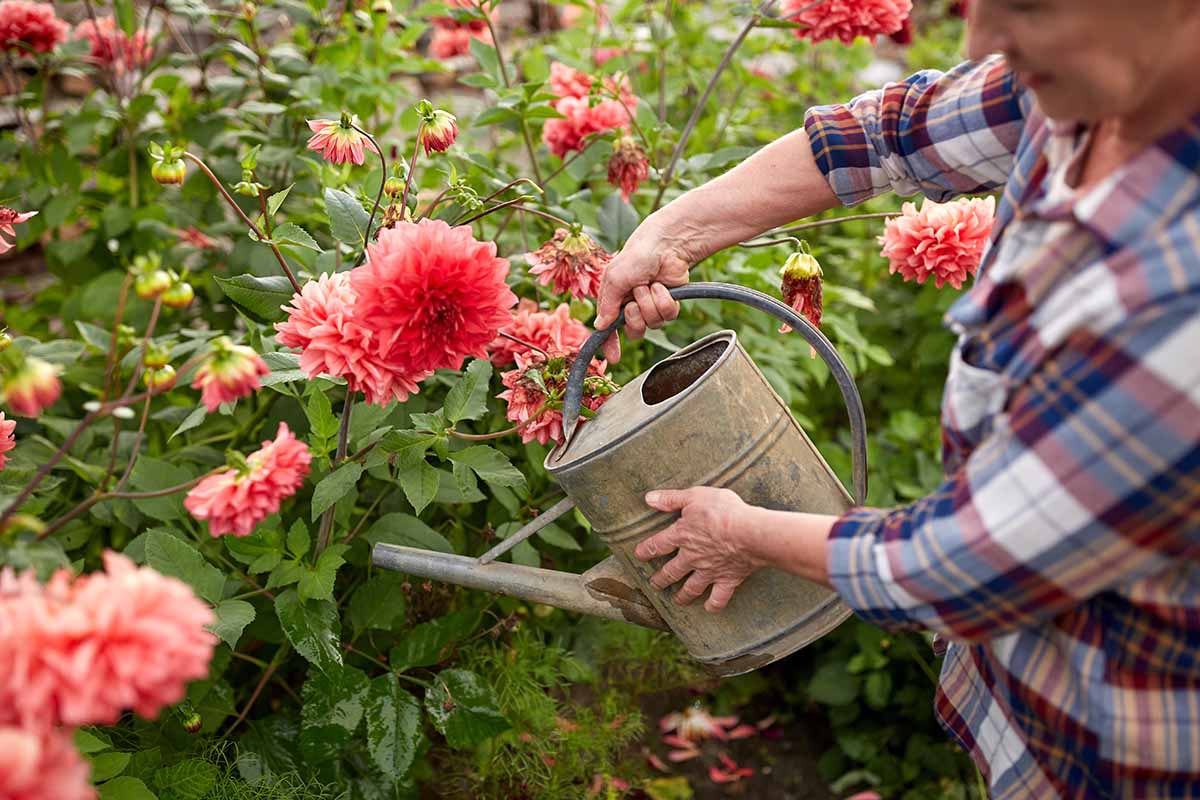
Young dahlias need more water than those that are established.
When they’re under a foot tall, keep the soil moist but not wet. Once they’re taller than a foot, water when the top inch of soil has dried out.
Learn more about watering dahlias in our comprehensive guide.
Once the plants are a foot tall, it’s also time to start feeding them once a month with a flower-specific food.
My favorite is Down to Earth’s Rose & Flower Mix, in part because it comes in compostable boxes, and it has always made my plants happy.
Down to Earth Rose & Flower Mix
Arbico Organics carries it in one-, five-, or 15-pound boxes. But if you have a favorite flower food, it’s also fine to go with what you know.
Be careful with using just straight nitrogen, this can cause plants to put most of its efforts into foliage growth rather than flowering and they can even fail to bloom.
Once the plant is about 10 inches tall, pinch off the central growing stem right above a stem that has at least four leaves. Don’t tear the stem – use clean scissors or your fingernails.
This encourages branching and will result in more flowers.
Check out our guide to growing dahlias for more information.
Staking
For pretty much any plant that reaches heights taller than three feet, you’re going to walk to stake the largest flower stems.
Smaller stems, which typically grow later in the year, might not need any staking.
The plants start developing flower buds when they’re young. As those buds start rising up on the growing stems, stick a stake next to the plant and tie it in.
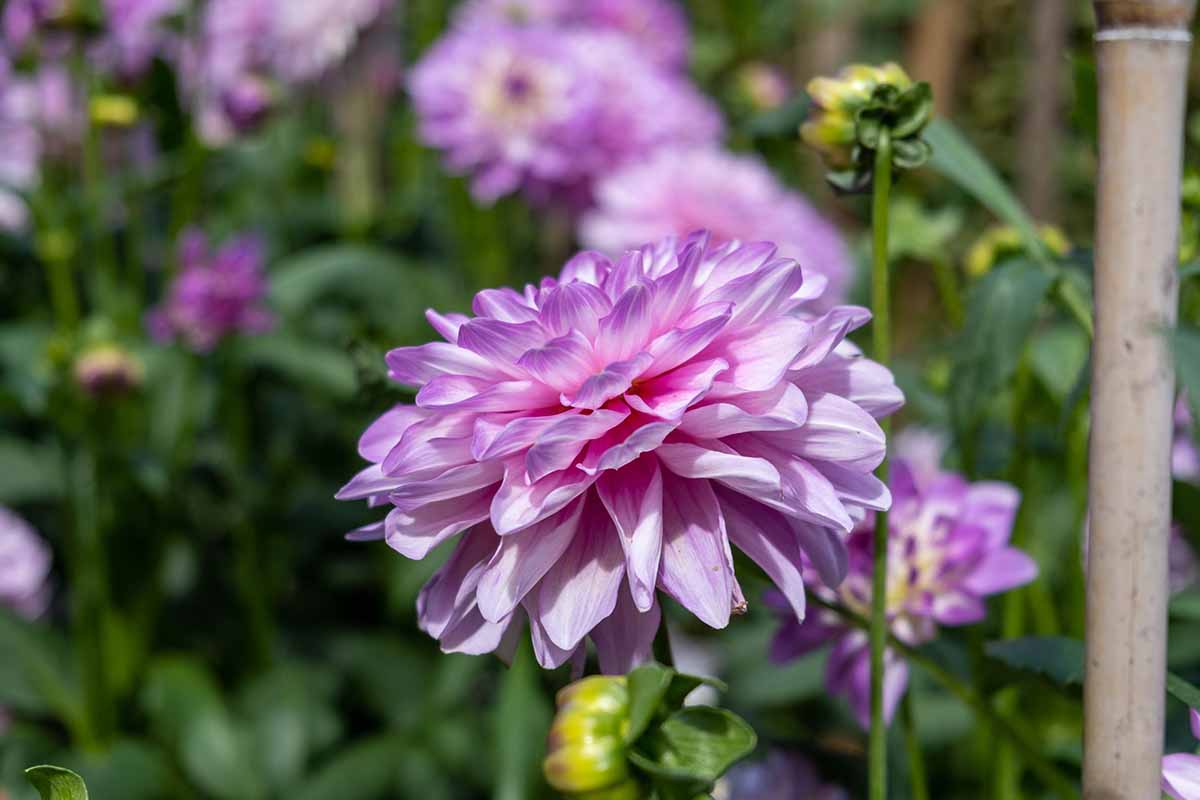
You can also place the stake when you first put the plant in the ground. The younger they are when you start staking your dahlias, the better off they’ll be. You run a real risk of damaging the tubers the longer you wait.
If you stake after planting, gently insert a six-foot stake at least a foot into the ground and a foot away from the plant when the dahlia is a foot tall.
Insert it carefully, wiggling as you go, so you don’t damage the roots. If you feel resistance, lift the stake and move it a bit. Repeat on the other side of the plant.
Don’t use thin bamboo stakes. You need to use something sturdy.
Stakes made of steel and coated in plastic are generally much sturdier than wood or bamboo.
For example, these steel and plastic stakes by Garmeinea come in 48- and 60-inch heights, which are about right for these tall dahlias.

You can pick a pack of 25 up at Amazon.
Take a piece of twine, attach it to the first stake, and run it to the next stake.
Loop around the second stake and go back to the first stake. Now the dahlia stem should be held securely between the two pieces of twine.
As the plant grows, you’ll need to assist it so it doesn’t grow outside the twine or bump into any string you might have placed above it.
You’ll also need to add new layers every six inches to a foot going up vertically as the plant grows.
If that sounds like too much work, you can also use one of those tall, square tomato cages.
For tips on training and supporting dahlias, read our full guide.
Growing Tips
- Grow in full sunlight.
- Pinch the main stem when plants are 10 inches tall.
- Stake stems before they reach a foot in height.
- Fertilize monthly starting when plants are a foot tall.
Pruning and Maintenance
Beyond pruning off any damaged or diseased leaves, you don’t need to do much in the way of pruning. But deadheading and cutting blossoms is another matter.
The more flowers you take, the more your plant will produce, so don’t be shy. Go out every few days once the plant starts blooming, and use a sharp pair of scissors to cut young blossoms.
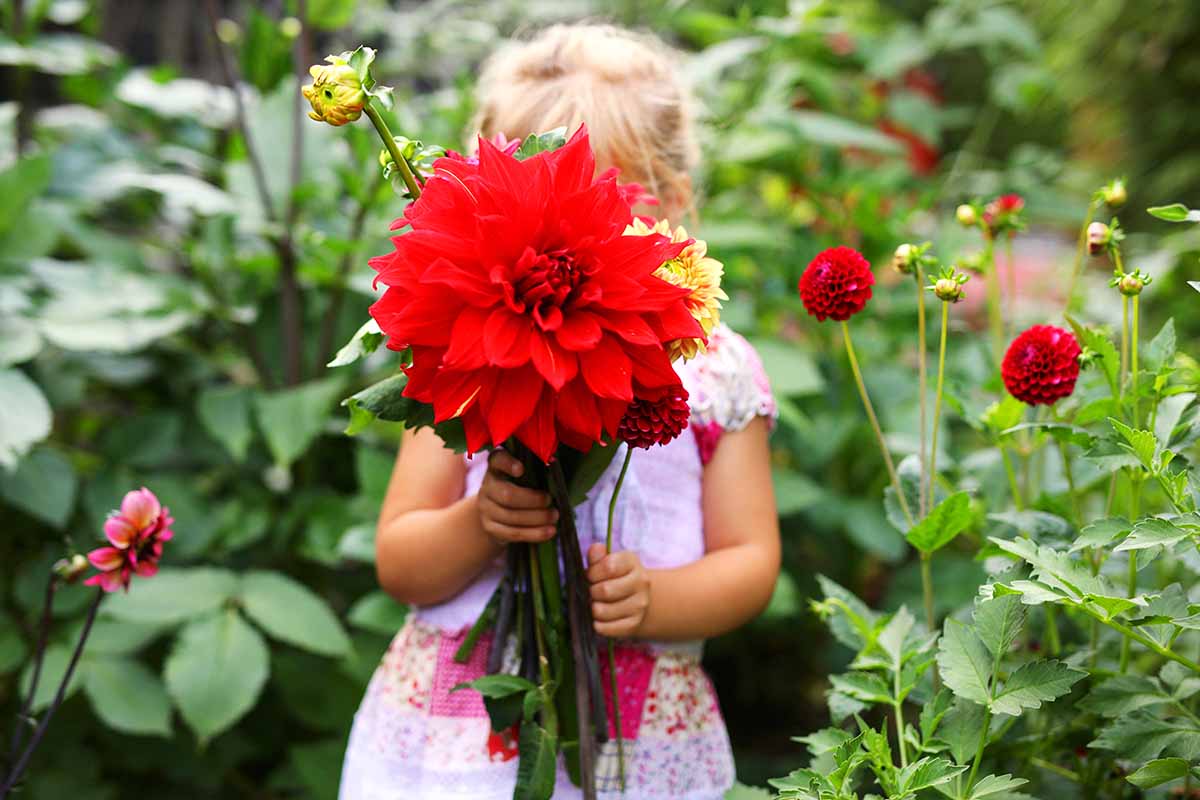
Try to cut stems that are at least six inches long, even if it means taking a few flower buds. Don’t worry, the plant will replace those buds.
You want to cut flowers that are young and recently opened. The back petals shouldn’t be soft and fading.
Put the cut stems in water immediately.
If you decide to keep the flowers on the plant in the garden, deadhead the blossoms as they begin to turn brown. Don’t wait until all the petals have fallen off.
Trim back to the nearest leaf joint or where the flower stem meets the main stem.
Cultivars to Select
There are two classifications of decorative types of dinnerplate dahlias: formal and informal.
Formal types have petals that grow in an even pattern. The petals are usually flat.
Informal types have petals that can be slightly rolled, particularly at the tips. The petals grow in an irregular pattern.
The petals at the center of the flower will usually be curled, regardless of type.
Here are a few that deserve a spot in your garden:
Bristol Stripe
With nine-inch-wide fully double blossoms, ‘Bristol Stripe’ is already perfectly poised to grab all the attention.
The white and violet-fuchsia striped petals just solidify this flower’s status as one that’s “impossible to ignore.”
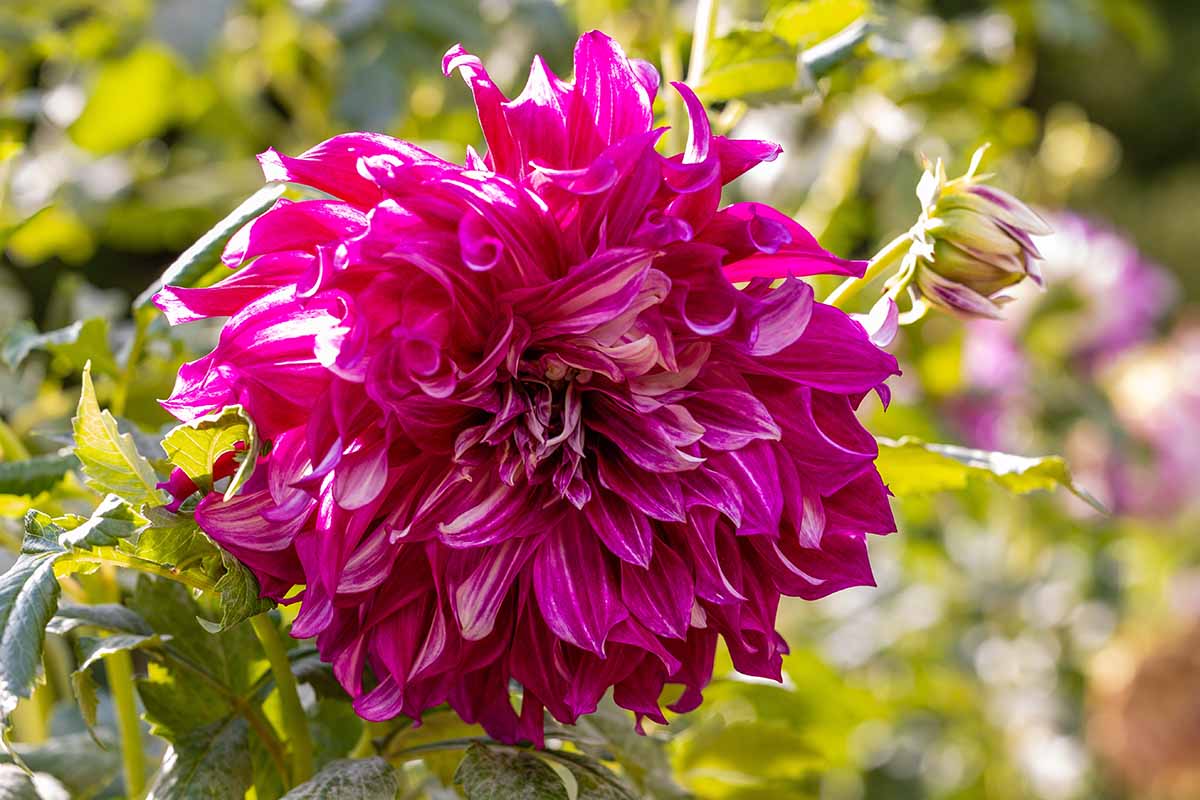
The stripes can vary from narrow to wide and might be solid or broken, so each petal – and flower – is totally unique. At the center is a faint flush of yellow.
Some blossoms might have an abundance of white petals and others might be primarily violet-fuchsia.
It’s a constantly-surprising treat on an informal-class plant.
Cafe au Lait
Sit down with a cup of coffee and get to know one of the most popular dinnerplate dahlias on the market today.
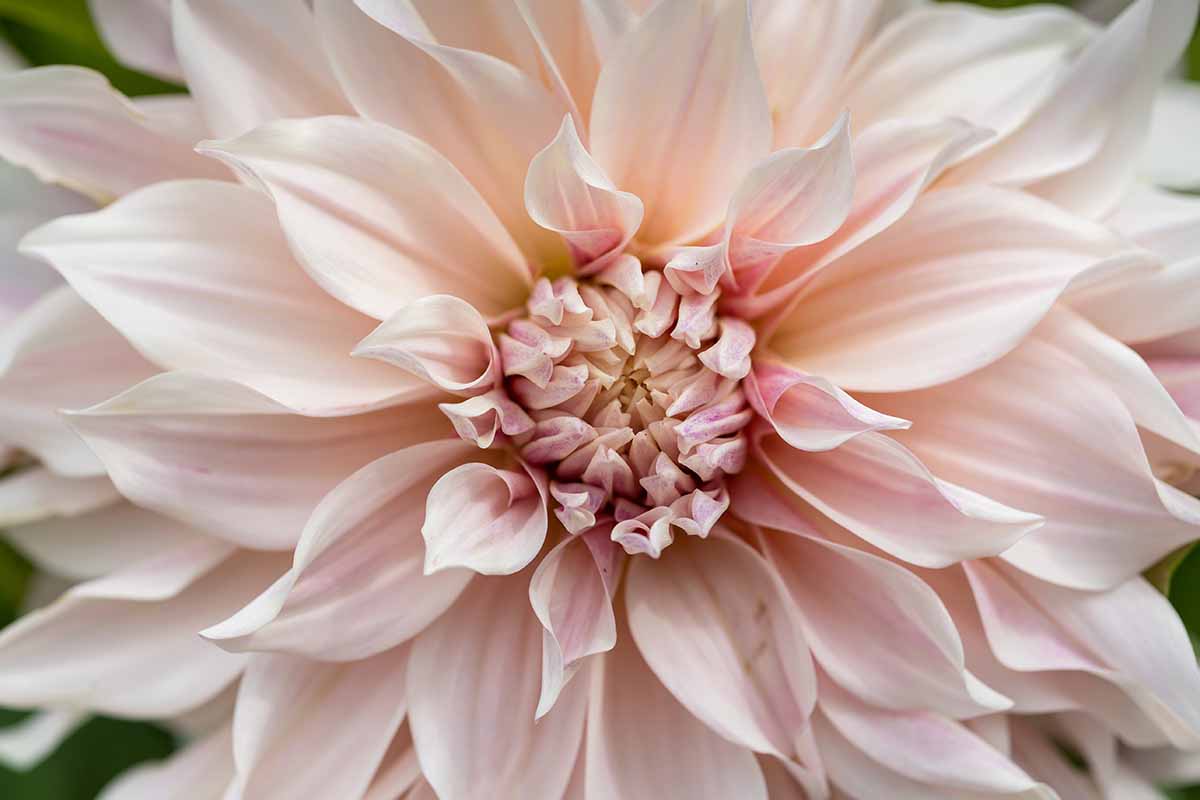
‘Cafe au Lait’ is a favorite for bridal bouquets and floral arrangements, but part of what I love about it is that it’s a constant surprise.
The eight-inch informal flowers can be a creamy tan, almost like a steaming cup of cafe au lait, but the flowers might also be peach, blush, or pale violet, all on the same plant.
The only thing you can be certain of is that you’ll be growing some incredible double blossoms.
Coffee’s ready! Get these tubers while they’re hot at Eden Brothers in packs of two, four, or eight.
Emory Paul
Dinnerplates are massive, but ‘Emory Paul’ makes most of them look like appetizer plates.
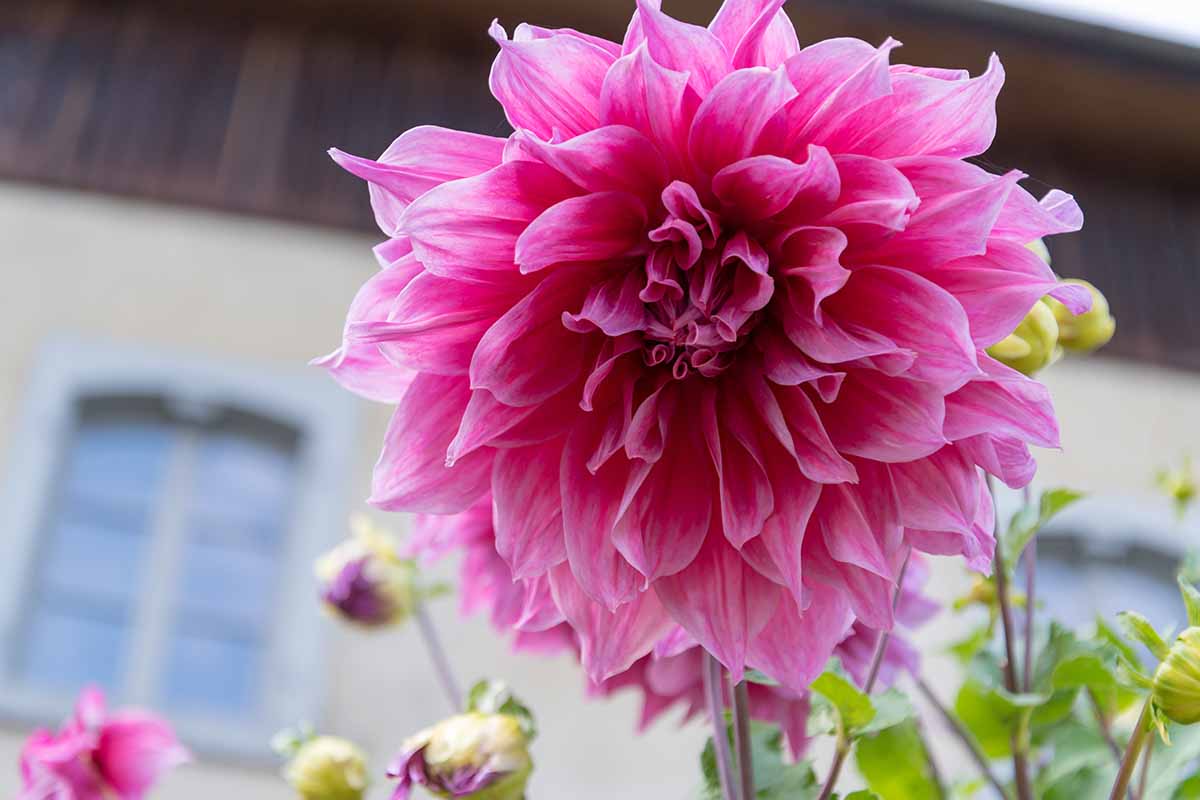
The fuchsia pink, formal flowers can grow over 14 inches in diameter on four-foot stems.
But the compromise is that you’ll have to wait a little bit longer than usual for the flowers to fully emerge.
Make two, four, or eight tubers yours by visiting Eden Brothers.
Ferncliff Illusion
With flowers up to 10 inches in diameter, this dahlia already commands attention. But with white blossoms tipped in vibrant fuchsia, there’s no looking away.
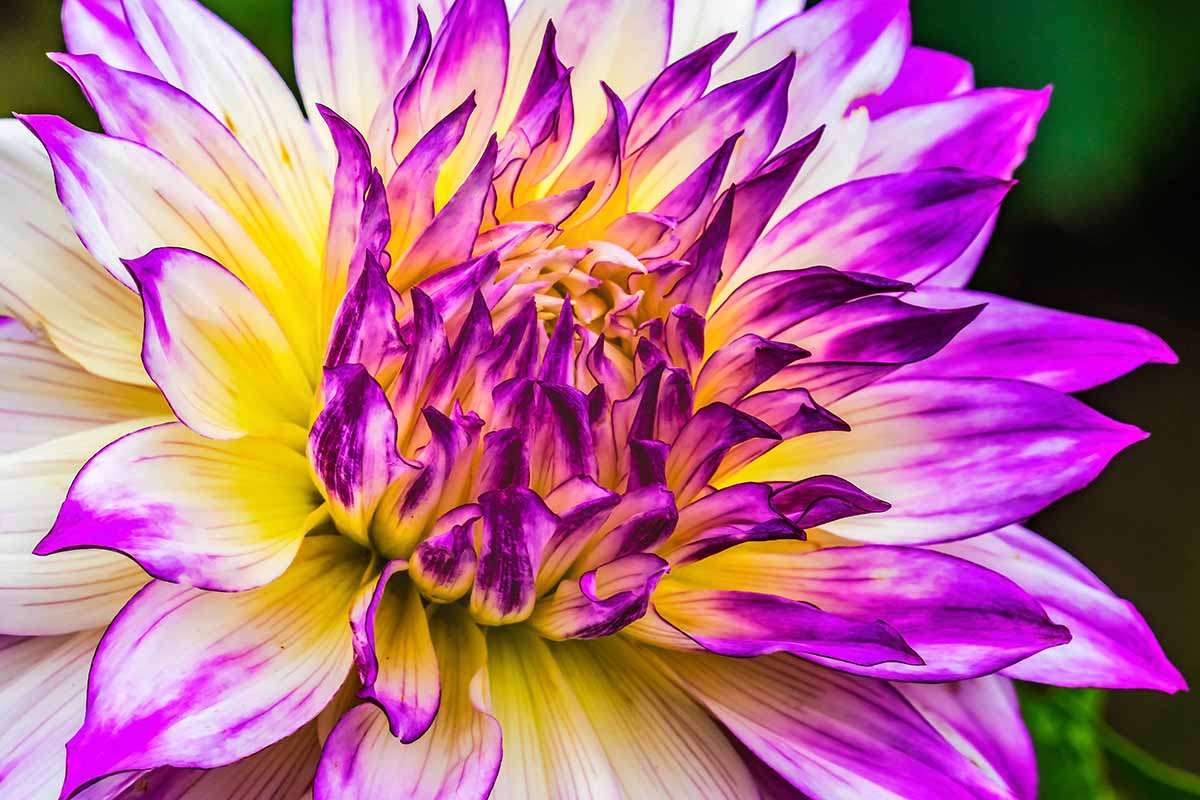
The plant can grow over five feet high, making it even more of an attention-grabber.
But what makes it extra special is that it’s an extremely vigorous plant. It will grow numerous tubers that you can divide so you can fill your garden with ‘Ferncliff Illusion.’
Fleurel
I’m all for a big, colorful display, but sometimes a little restraint is in order.

Whether you use the eight-inch blossoms of ‘Fleurel’ for a bridal bouquet or to bring a moment of serenity to your garden, this elegant informal dahlia is a classic beauty that whispers rather than shouting.
The twisted petals add a ruffled texture to the appearance.
The plant itself can grow to about four feet tall, though it usually stays a bit shorter.
Kelvin Floodlight
If I ever become a respected engineer and physicist, I hope people honor me with a dahlia as beautiful as ‘Kelvin Floodlight.’
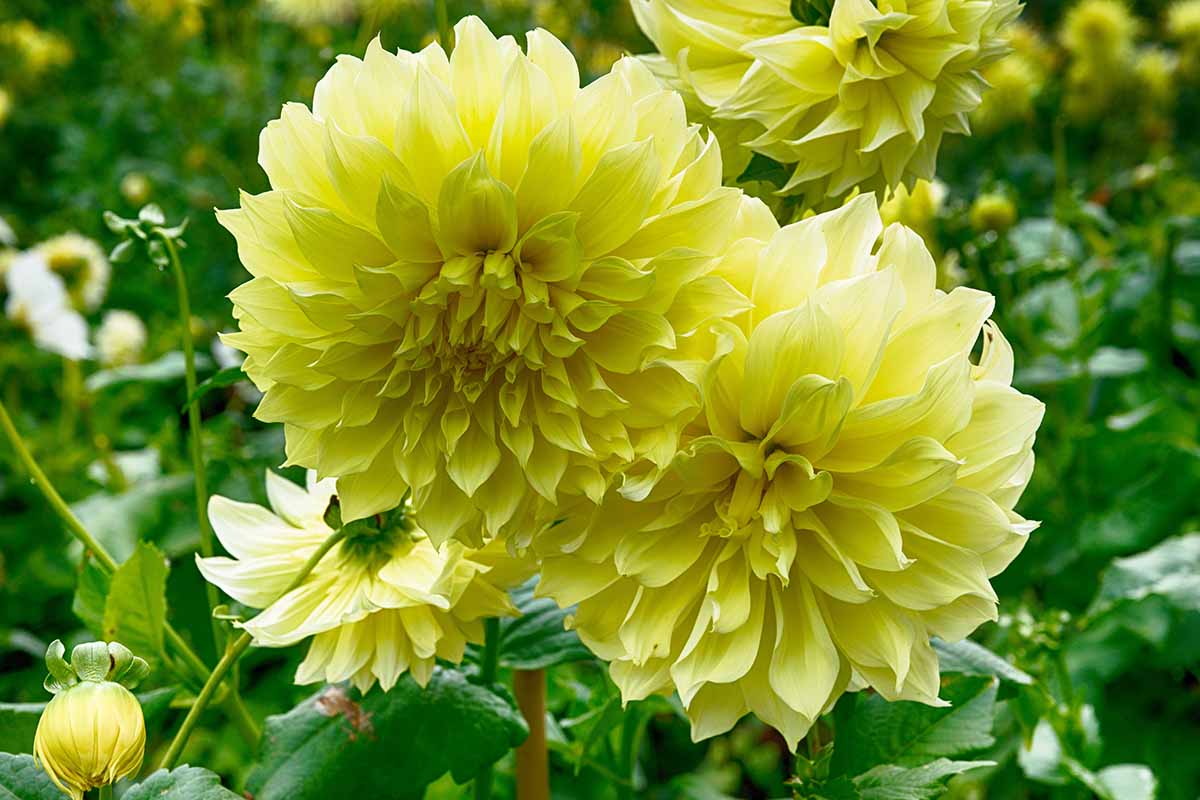
This yellow formal type shines as brightly as the sun, seemingly flooding the garden with light.
The massive heads can be over 10 inches wide.
Labyrinth
Looking at the peach and pink blossoms on ‘Labyrinth,’ it’s easy to feel like you’ve gotten lost in a watercolor painting of a summer sunset.
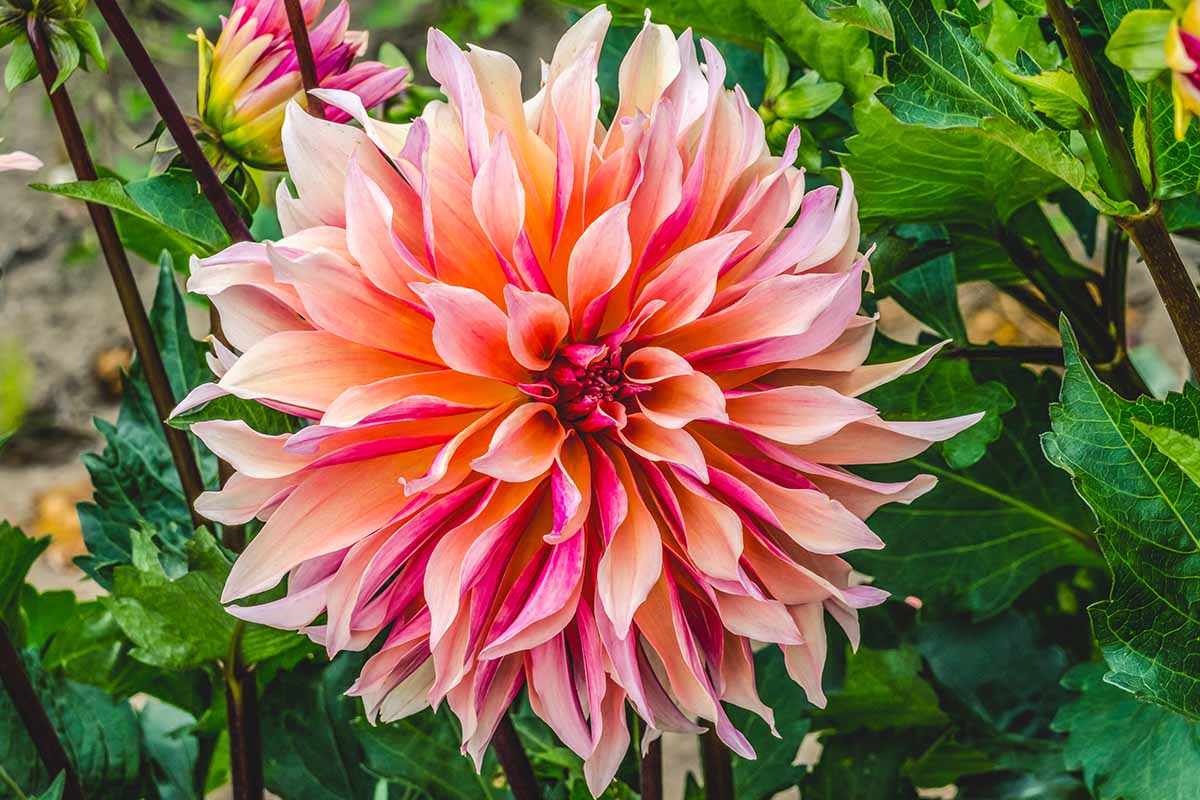
The curling petals are shades of pink, peach, and creamy salmon, blending together in a swirl of pastels.
This informal type might be as small as three feet in height, but it will grow up to four feet tall in the right conditions.
This is one dahlia I wait in anticipation for each year. If you’d like to add it to your garden, visit Eden Brothers for a pack of two, four, or eight tubers.
There’s also a newer red version of this cultivar, with red and pink petals. It’s also available at Eden Brothers in the same quantities.
Otto’s Thrill
Bright pink, 10-inch informal flowers with pastel pink tips are the hallmark of ‘Otto’s Thrill.’ In fact, anyone looking for a floral focal point will be thrilled with this decorative dinnerplate dahlia.
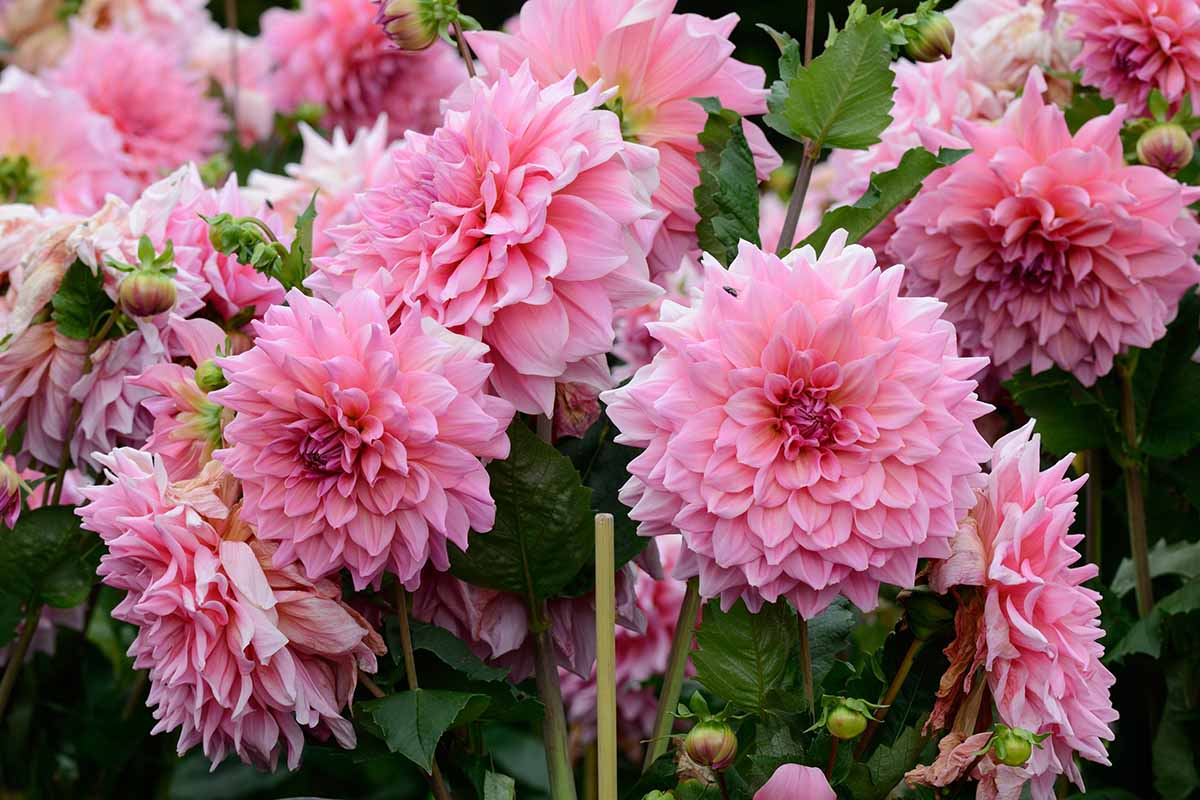
Not only are the cotton candy blossoms eye-catching, but the stems are often strong enough to stand on their own without staking.
Penhill
Penhill is a series of dinnerplates that can grow five feet tall with 10-inch blossoms.
The petals of this informal type are all twisted and curled, coming to a sharp point at the end, making the plant look like a pastel fire.
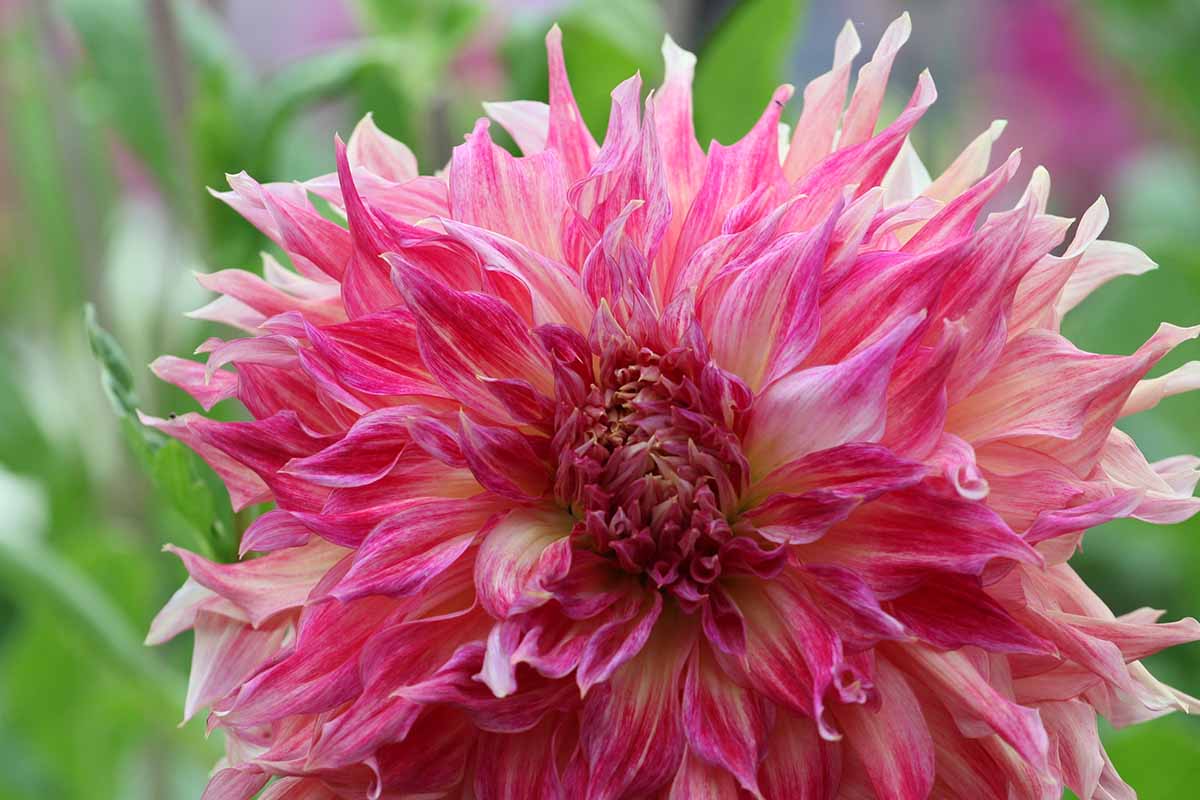
There are several colors in this series, including the deep pink ‘Dark Monarch’ and the yellow and salmon ‘Autumn.’
But the color of Penhill ‘Watermelon’ is the most popular, for good reason. The petals are an airy mixture of coral pinks.
For two, four, or eight ‘Watermelon’ tubers, visit Eden Brothers.
Managing Pests and Disease
You don’t need to worry about herbivores pestering your dahlias, but pests like snails and aphids will.
Less often, thrips and cutworms, like the large yellow underwing (Noctua pronuba) and the variegated cutworm (Peridroma saucia), will visit.
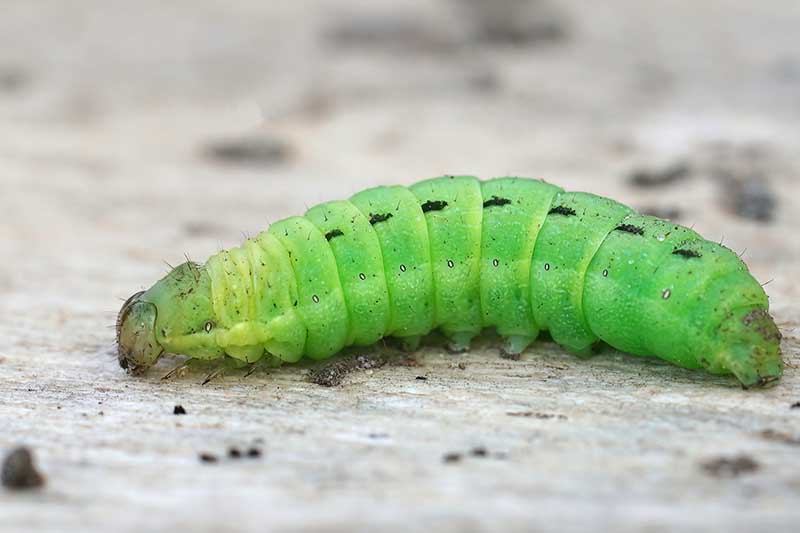
Cutworms pose the biggest threat when the plants are young. The caterpillars will mow down young plants at the soil level.
When plants are older, cutworms just nibble on the leaves and don’t do much real damage.
For tips on how to protect your young dahlias, read our cutworm guide.
For the full rundown on dahlia pests, our article has all the details. Dinnerplate dahlias are susceptible to all of the pests described here.
As far as diseases go, botrytis blight,caused by Botrytis cinerea, and powdery mildew, caused by Golovinomyces cichoracearum, are the most common issues. If you see gray mold or a powdery coating on your plants, it’s likely one of these two problems.
Learn more about dealing with powdery mildew in dahlias here.
Stem rot and verticillium wilt are less common.
The former, caused by Pectobacterium carotovorum (formerly Erwinia carotovora) bacteria, leads to stem collapse and rotten areas that appear on the stem. And the latter is a fungal infection that causes plants to wilt and die.
To address all of these diseases except stem rot and powdery mildew, which you can learn more about in our article, a fungicide like Mycostop can help to eliminate the pathogens.
Pick up five or 25 grams at Arbico Organics and follow the manufacturer’s directions.
Best Uses for Dinnerplate Dahlia Flowers
These massive flowers are best suited for planting in groupings or in cut flower gardens. You can also combine them with snapdragons, zinnias, and geraniums.
For a selection of other excellent options, check out our guide to companion planting with dahlias.

If you cut the flowers, remember that they don’t open much more once you’ve severed them from the plant.
Look at the back petals. If they’re soft or fading, you waited a bit too long to pick. You want them just as soon as they’ve opened fully.
Re-cut the stems under running water, place in a vase and change the water daily, and they should last for up to a week. If they start to droop, recut the stems under water.
These aren’t the best dahlia options for container growing unless you have a massive pot. They’re just too top-heavy and large.
By the way, if you want to try eating the tubers, feel free. But dinnerplate types aren’t the best ones to use for this purpose.
You want the smaller-flowered, heirloom types if you’re looking for a tuber that tastes even remotely good. I can tell you from experience that dinnerplate tubers are bland.
Quick Reference Growing Guide
| Plant Type: | Herbaceous flowering perennial | Flower / Foliage Color: | White, pink, red, yellow, orange, purple/green |
| Native to: | Mexico | Maintenance: | Moderate |
| Hardiness (USDA Zone): | 8-10 | Tolerance: | Some drought |
| Bloom Time: | Summer, fall | Soil Type: | Loose, rich |
| Exposure: | Full sun | Soil pH: | 6.5-7.0 |
| Time to Maturity: | 16 weeks | Soil Drainage: | Well-draining |
| Spacing: | 18 inches | Companion Planting: | Geraniums, snapdragons, zinnias |
| Planting Depth: | 1/8 inch (seeds), 1-2 inches (tubers) | Uses: | Cut flower, group planting |
| Height: | Up to 5 feet | Order: | Asterales |
| Spread: | 32 inches | Family: | Asteraceae |
| Growth Rate: | Fast | Subfamily: | Asteroideae |
| Water Needs: | Moderate | Tribe: | Coreopsideae |
| Common Pests and Diseases: | Aphids, cutworms, slugs, thrips; Botrytis blight, powdery mildew, stem rot, wilt | Genus: | Dahlia |
Dinner’s On!
Big isn’t always better, but in this case, it certainly is.
The huge blossoms of dinnerplate dahlias only serve to emphasize the dramatic shape and color of the flowers. If you love dahlias, dinnerplates offer more bang for your dahlia buck.
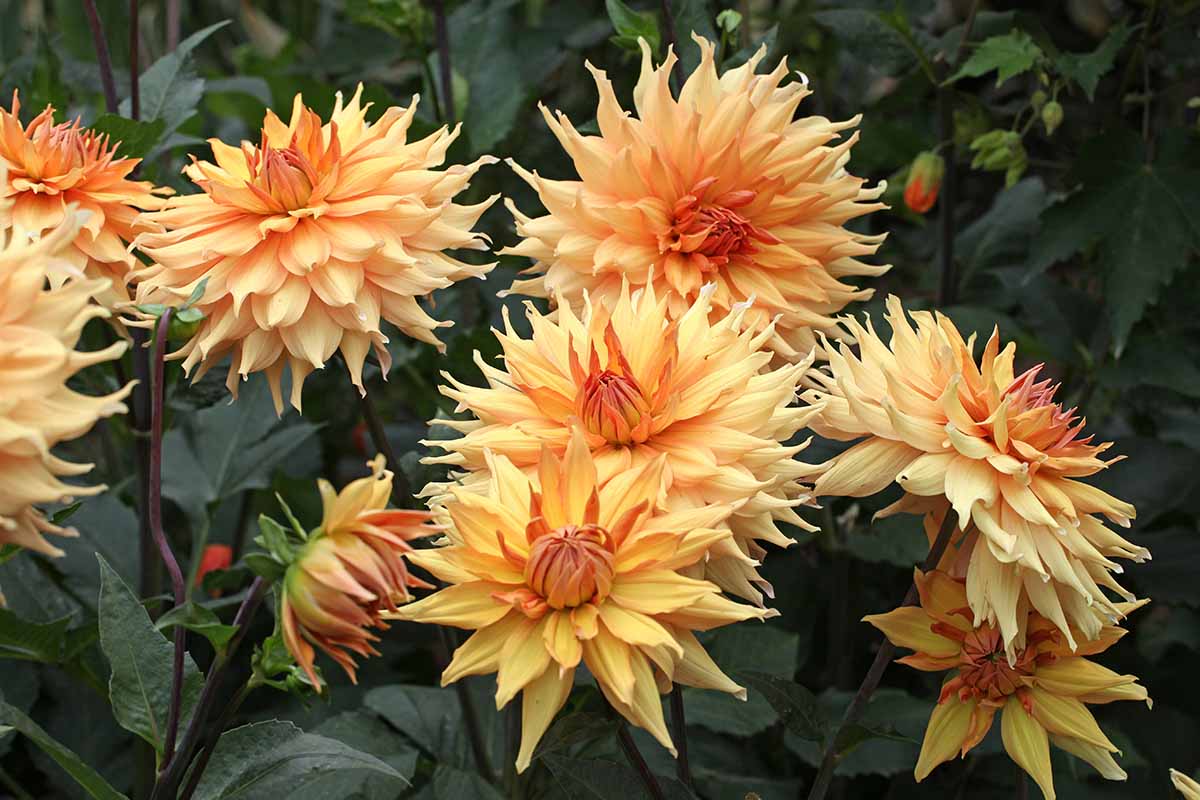
Which dinnerplate is your favorite? Are you growing yours to use in cut displays or bouquets? Tell us all about your plans.
If you’re looking for more ways to use dahlias in mixed plantings, whether in an eye-catching grouping or in a pollinator garden, these guides can shed some light on the next steps:

